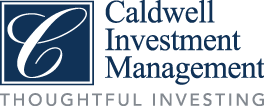Caldwell’s Top Ten Themes January 2016
As we start 2016, we have compiled a top ten list, à la David Letterman, of investment themes that will be topical for investors this year. To be sure, as Mark Twain wrote “prophesy is a good line of business, but it is full of risk”.
1) Global growth improves. Recession fears overblown. Global GDP growth improves slightly, increasing from 3.2% to 3.6%. The positive effects of lower commodity prices will start to be reflected improving economic numbers. The narrative of a global economy heading into a recession while loud in the early part of the year, will fade away as economic numbers support a slow growth in a “steady as she goes” recovery.
2) Mistakes in inflationary expectations will be corrected. Inflation, job growth and wage increase surprises to the upside in the U.S.A. supports stable growth, and gives the Federal Reserve air cover to raise rates further in 2016. The Monetary Normalization process will confuse many investors. The Federal Reserve is on track to raise short-term rates four times in 2016, the financial market has put a very low probability of this happening. We stand by the old rule of “don’t fight the Fed”.
3) Evolution from analog to digital economy continues. In a slow growth world, companies that embrace this evolutionary process will have expanding margins and will gain market share. All companies are now technology companies.
4) China’s two speed economy continues adjustment, no hard landing. Additional devaluation of the Yuan possible. China’s growth will continue to slow. We forecast GDP growth closer to 6.5% than 7%. Policy makers may have to cut interest rates to support economic growth. Extreme volatility in the stock market will continue.
5) Stocks will outperform bonds in 2016. Companies that have positioned their business model to gain market share and return cash flow to shareholders will outperform. By the end of 2016, the breadth of the market will increase, and value will outperform growth. Equity valuations will be supported by dividends and share buy backs. Recovery in oil prices and a steepening yield curve point to value outperforming growth in 2016.
6) Commodity prices stabilize and rebound. No, this is not the beginning of a new commodity super cycle. That being said, oil could appreciate 30% by year-end. Industrial commodity prices could also stabilize. Cuts in capital expenditures, plus output reductions, should help the commodity market stabilize. For this to happen, however, some market participants may wait to see further weakness during the first half of the year before taking these necessary actions.
7) Less liquidity and more volatility in the bond market. The bond markets evolution away from “principal” based trading to one based upon “agency” continues, causing spreads to stay at historically high levels. The interpretation that the widening credit spreads are foretelling of a global recession is misplaced.
8) Divergence in global monetary policies. In the United States, The Federal Reserve continues to raise interest rates as part of its monetary policy normalization process. Conversely, the European Central Bank and The Bank of Japan continue unconventional monetary policy, putting upward pressure on risk asserts in their respective economies. The Middle East Cold War will continue to escalate, putting pressure on oil exporting nation’s monetary policy and fiscal budgets.
9) Canadian economy avoids recession but performs below potential. While a recovery in oil prices in the second half of 2016 is a positive, underperformance in the non-energy export sector counterbalances optimism. The recovery of oil prices is supportive of equity prices, helping the Canadian dollar to stabilize. The Bank of Canada finally recognizes that the economy faces a long adjustment process and suggests the possibility of the introduction of unconventional monetary policies (Negative Interest Rates). In addition, The Bank of Canada continues to communicate its desire to adjust its inflation target, to more accurately take into account the changing dynamics of the Canadian and Global economies.
10) The emerging market capital flow bonanza comes to an end. Capital continues to flow out of the Emerging Markets. With interest rates rising in the U.S.A., capital continues to flow out of the Emerging Market, ushering the global economy into a new regime of rising default risk for Emerging Market sovereign debt.
Winston Churchill stated “I always avoid prophesying beforehand because it is much better to prophesy after the event has already taken place”.
James E. Thorne, Ph.D.
Chief Capital Market Strategist
JThorne-CaldwellsTopTenThemes-January2016.pdf
-
Curtis Luttorhttps://caldwellinvestment.com/author/cluttor/
-
Curtis Luttorhttps://caldwellinvestment.com/author/cluttor/
-
Curtis Luttorhttps://caldwellinvestment.com/author/cluttor/
-
Curtis Luttorhttps://caldwellinvestment.com/author/cluttor/
